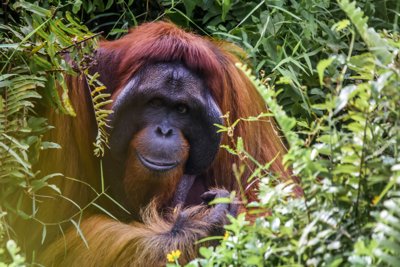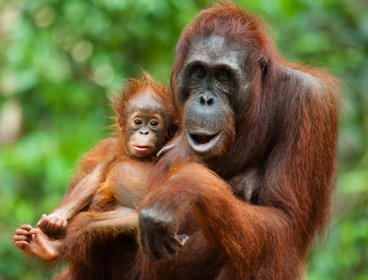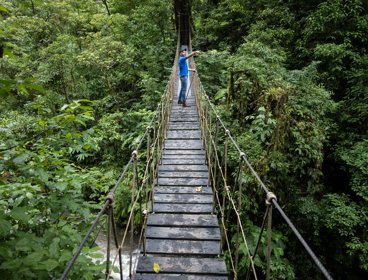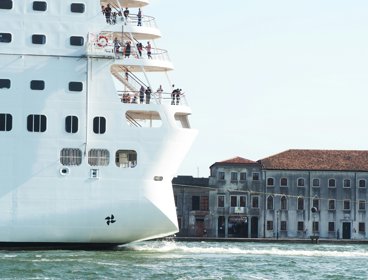June 2015
What attracts visitors to Borneo?
Asia’s largest island, Borneo, is fast becoming a destination of choice for tourists keen to experience unusual wildlife and natural landscapes. The island which is divided between Indonesia (making up the largest part), Malaysia and Brunei has some of the world’s oldest virgin rainforest, with large sections of the island estimated to be one hundred and forty million years old. Visitors often come to try and see the island’s endangered animal residents such as the Pygmy Asian Elephant, Hose’s Civet and the Sunda Clouded Leopard, as well as its most famous endemic species: the Bornean Orang-utan.
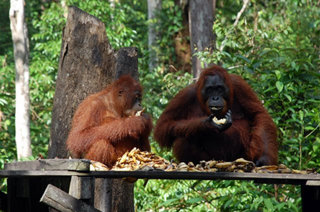
With a population density ten times less than that of the UK, (World Bank Data, 2014) Borneo is attractive for many visitors precisely because it is largely undeveloped. Many tourists are drawn by the island’s landscapes: mountains with extensive cave systems to explore are found in the north of the island and are surrounded in thick rainforest divided into sections by rivers and waterfalls. New floral species are being found every year and the island can be a paradise for wildlife lovers who are looking for a raw experience and the chance to ‘get back to nature’. The island also boasts strong social history with many of the traditions of the Dayak people (the island’s indigenous culture) still being seen in everyday life, and cities like Kuching boasting a strong and interesting trade history.
The types of ecotourism on offer in Borneo
More economically viable long distance flights opened up Borneo to wildlife tourism in the early 1980s (Sabah Parks, 2007). Initially tourism was a small and relatively easy to control venture, but as it grew in popularity, so did the rise of ecotourism principles in tourism more widely. Borneo, with its tourism focussed on wildlife and the natural landscape, has embraced many ecotourism ideas.
We believe that ecotourism as a conservation-based enterprise, will help generate revenues for the district, bring economic benefits to local communities, and help protect the natural assets of the Malinau District for present and future generations.
Semion Udan, Head of the Tourism Office, Malinau District (source WWF 2007)
Soft trekking (walking through the rainforest on easy to follow trails) features on many tour itineraries, as does a trip to an orang-utan sanctuary or rehabilitation centre in the centre of a national park. Here visitors can pay to see the primates in semi-natural settings and learn about them, funds which in large part contribute to their rehabilitation and conservation. Many tour groups are kept purposefully small and accommodation is often in lodges built from local materials within jungle clearings, as well as on traditional houseboats, in long houses or as homestay visits with villagers whose homes can only be reached by boats. Homestays can earn villagers over Rp150,000 (£7.50) a night – about four times the average Indonesian daily wage (WWF, 2007). Dayak guided tours of forests areas and visits to floating markets are also popular activities for tourists to book.
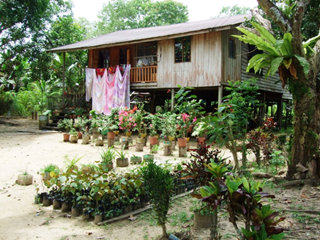
At Kayan Mentarang National Park in Malinau, Indonesia, the local tourism office is working in partnership with WWF to encourage more people to explore the different ecotourism options available. Tourists are urged to visit the park’s areas of montane forest using motorised canoes along its rivers as well as villages that would otherwise be cut off from the positive economic impact tourists can bring. Hiring a trekking guide for the forest can earn a local person up to Rp120,000 a day (WWF, 2007) and many villagers take the opportunity to sell wood carvings and traditionally made rattan wares to their visitors. Tourists are also encouraged to visit the Lalut Birai Tropical Forest Research Station where they can learn about the forest environment, how it is threatened and what groups such as WWF are doing to protect it.
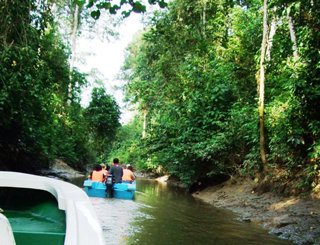
The alternative view of ecotourism in Borneo
Despite Borneo’s tourism industry growing at the same time as the rise of ecotourism, one cannot always say that the two have been synonymous nor worked in harmony with each other. Tourists looking for a holiday that involves wildlife and unique natural setting are spoilt in Borneo but even a quick look through advertised ‘ecotourism’ packages shows that many tour companies are using the title as a brand name with questions being raised about how far the guiding principles of eco-tourism are applied to their activities and the type of holiday they offer.
There have been concerns that much of the authenticity behind the ‘wilderness tourism’ on offer in Borneo has been lost in recent years (Luquiau, 2012). As money from tourism has started to flow into more remote village areas, the traditional Dayak culture that tourists like to see has been eroded, with brick houses replacing those made from rattan and other forest materials. Homes that have retained their Dayak style in some areas are now the ‘show homes’ that are specifically kept that way for tourists to visit. In fact many of the so-called ‘eco-lodges’ are in fact owned by foreign and city based companies who rent the land at nominal prices from villagers. Many do not employ local people, neither within the lodge nor as guides, largely because they lack the language skills (such as being fluent in English) that tourists require.
Those villagers who offer their homes for homestay accommodation are often spending an increasing proportion of their income from tourism on providing somewhat sanitised and standardised arrangements for their guests (Luquiau, 2012) who themselves may be liking the idea of staying in a homestay rather than its sometimes challenging and less comfortable reality.
Conclusion
Like many tourism destinations in the Tropics, Borneo offers its visitors a chance to experience rainforests and wildlife in a relatively unspoilt way. While eco-tour groups remain small and manageable, there is still an opportunity for the principles of ecotourism to extend to most of the tourism activity on the island. However as tourism grows on the island tour companies must be conscious of not losing sight of the environmentally and culturally friendly ideologies that will ensure their longevity.
References
Balai Taman Nasional Kayan Mentarang and WWF (2007) Guidebook: Ecotourism destinations in the Kayan Mentarang National Park, WWF
Luquiau, C. (2012) Borneo’s ecotourism problem, Le Monde diplomatique [translated from original text]
Sabah Parks, (2007) Park Enactment 1984
World Bank Data (2014) Population density
Key Words
Conservation
The act of preserving, protecting and managing biodiversity or a resource.
Ecosystem
A set of living organisms that interact with non-living components to create a system of inputs, processes and outputs.
Ecotourism
Responsible travel to natural areas where active steps are taken to conserve the environment and improve the well-being of local people.
Endangered
A species that according to the IUCN Red List is likely to become extinct.
Indigenous
The original inhabitants of a place.
Sustainability
Development that aims to increase standards of living without destroying the environment while safeguarding natural resources for future generations.
Lesson Ideas
Students can be given two alternative scenarios: 1. Borneo continues to follow some, but not all ecotourism principles and 2. It halts current activities and moves towards activities that are more clearly centred on ecotourism. Students can then project forward to 2050 and describe what Borneo’s society, economy and environment might look like under each scenario.
Students can design the ultimate ecotourism holiday in Borneo. Researching the different districts and likely prices they can put together a brochure (with environmentally sound design) to highlight the different ecotourism principles on offer.
Starting in the 1980s, students can draw a flow diagram that shows how the island has gone from almost no tourism to its current level. This can be paired with a line graph showing the growth in tourism numbers over time which students can research.
Links
File nameFiles
File type
Size
Download
